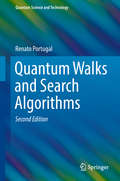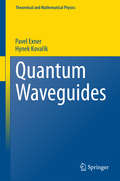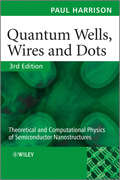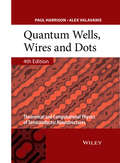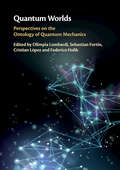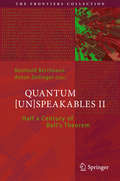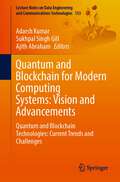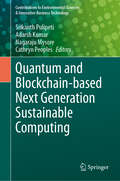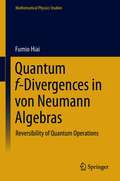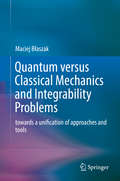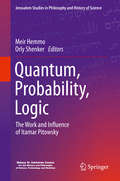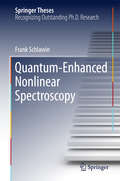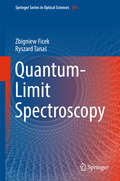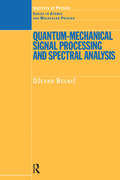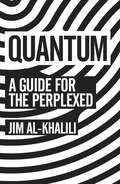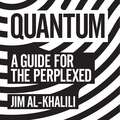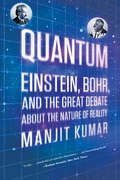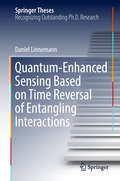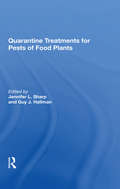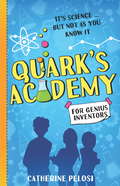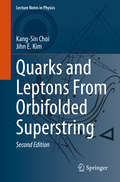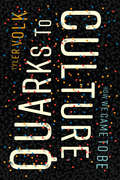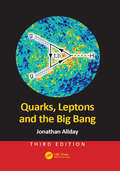- Table View
- List View
Quantum Walks and Search Algorithms (Quantum Science and Technology)
by Renato PortugalThe revised edition of this book offers an extended overview of quantum walks and explains their role in building quantum algorithms, in particular search algorithms.Updated throughout, the book focuses on core topics including Grover's algorithm and the most important quantum walk models, such as the coined, continuous-time, and Szedgedy's quantum walk models. There is a new chapter describing the staggered quantum walk model. The chapter on spatial search algorithms has been rewritten to offer a more comprehensive approach and a new chapter describing the element distinctness algorithm has been added. There is a new appendix on graph theory highlighting the importance of graph theory to quantum walks.As before, the reader will benefit from the pedagogical elements of the book, which include exercises and references to deepen the reader's understanding, and guidelines for the use of computer programs to simulate the evolution of quantum walks.Review of the first edition:“The book is nicely written, the concepts are introduced naturally, and many meaningful connections between them are highlighted. The author proposes a series of exercises that help the reader get some working experience with the presented concepts, facilitating a better understanding. Each chapter ends with a discussion of further references, pointing the reader to major results on the topics presented in the respective chapter.” - Florin Manea, zbMATH.
Quantum Waveguides
by Pavel Exner Hynek KovaříkThis monograph explains the theory of quantum waveguides, that is, dynamics of quantum particles confined to regions in the form of tubes, layers, networks, etc. The focus is on relations between the confinement geometry on the one hand and the spectral and scattering properties of the corresponding quantum Hamiltonians on the other. Perturbations of such operators, in particular, by external fields are also considered. The volume provides a unique summary of twenty-five years of research activity in this area and indicates ways in which the theory can develop further. The book is fairly self-contained. While it requires some broader mathematical physics background, all the basic concepts are properly explained and proofs of most theorems are given in detail, so there is no need for additional sources. Without a parallel in the literature, the monograph by Exner and Kovarik guides the reader through this new and exciting field.
Quantum Wells, Wires and Dots
by Paul HarrisonQuantum Wells, Wires and Dots, 3rd Edition is aimed at providing all the essential information, both theoretical and computational, in order that the reader can, starting from essentially nothing, understand how the electronic, optical and transport properties of semiconductor heterostructures are calculated. Completely revised and updated, this text is designed to lead the reader through a series of simple theoretical and computational implementations, and slowly build from solid foundations, to a level where the reader can begin to initiate theoretical investigations or explanations of their own.
Quantum Wells, Wires and Dots: Theoretical and Computational Physics of Semiconductor Nanostructures
by Paul Harrison Alex ValavanisQuantum Wells, Wires and Dots provides all the essential information, both theoretical and computational, to develop an understanding of the electronic, optical and transport properties of these semiconductor nanostructures. The book will lead the reader through comprehensive explanations and mathematical derivations to the point where they can design semiconductor nanostructures with the required electronic and optical properties for exploitation in these technologies. This fully revised and updated 4th edition features new sections that incorporate modern techniques and extensive new material including: - Properties of non-parabolic energy bands - Matrix solutions of the Poisson and Schrödinger equations - Critical thickness of strained materials - Carrier scattering by interface roughness, alloy disorder and impurities - Density matrix transport modelling -Thermal modelling Written by well-known authors in the field of semiconductor nanostructures and quantum optoelectronics, this user-friendly guide is presented in a lucid style with easy to follow steps, illustrative examples and questions and computational problems in each chapter to help the reader build solid foundations of understanding to a level where they can initiate their own theoretical investigations. Suitable for postgraduate students of semiconductor and condensed matter physics, the book is essential to all those researching in academic and industrial laboratories worldwide.
Quantum Worlds: Perspectives on the Ontology of Quantum Mechanics
by Olimpia Lombardi Sebastian Fortin Federico Holik Cristian LópezQuantum theory underpins much of modern physics and its implications draw the attention of industry, academia and public funding agencies. However there are many unsettled conceptual and philosophical problems in the interpretation of quantum mechanics which are a matter of extensive debate. These hotly debated topics include the meaning of the wave function, the nature of the quantum objects, the role of the observer, the non-locality of the quantum world, and the emergence of classicality from the quantum domain. Containing chapters written by eminent researchers from the fields of physics and philosophy, this book provides interdisciplinary, comprehensive and up-to-date perspectives of the problems related to the interpretation of quantum theory. It is ideal for academic researchers in physics and philosophy working on the ontology of quantum mechanics.
Quantum [Un]Speakables II
by Reinhold Bertlmann Anton ZeilingerThis self-contained essay collection is published to commemorate half a century of Bell's theorem. Like its much acclaimed predecessor "Quantum [Un]Speakables: From Bell to Quantum Information" (published 2002), it comprises essays by many of the worlds leading quantum physicists and philosophers. These revisit the foundations of quantum theory as well as elucidating the remarkable progress in quantum technologies achieved in the last couple of decades. Fundamental concepts such as entanglement, nonlocality and contextuality are described in an accessible manner and, alongside lively descriptions of the various theoretical and experimental approaches, the book also delivers interesting philosophical insights. The collection as a whole will serve as a broad introduction for students and newcomers as well as delighting the scientifically literate general reader.
Quantum and Blockchain for Modern Computing Systems: Quantum and Blockchain Technologies: Current Trends and Challenges (Lecture Notes on Data Engineering and Communications Technologies #133)
by Ajith Abraham Adarsh Kumar Sukhpal Singh GillThis book states that blockchain technology provides a secure distributed, peer-to-peer, and decentralized network with advanced cryptography primitives and protocols. The important question that arises in the quantum computing world is to test the existing blockchain networks against quantum attacks and design quantum computing enabled secure blockchain solutions. This book encourages professionals from different fields to provide blockchain and quantum technology-integrated solutions that incorporate low-cost, effective QoS, fast, secure, and futuristic demands. This book has surveyed and proposed approaches that improve quantum computing and cryptography protocols. Quantum computing and quantum science are not just helpful in software but the hardware world as well. To design networks with quantum science, quantum-enabled devices like quantum memories and quantum repeaters can be useful to demonstrate for organizations. For example, designing a single quantum repeater for long-distance quantum communication is useful in reducing the network cost, and ensuring better security levels. This book has introduced the quantum computing and blockchain technology aspects, their integration approaches and future directions.
Quantum and Blockchain-based Next Generation Sustainable Computing (Contributions to Environmental Sciences & Innovative Business Technology)
by Adarsh Kumar Cathryn Peoples Srikanth Pulipeti Nagaraju MysoreQuantum and Blockchain technology innovations have recently gained a lot of attention and have been integrated with other contemporary technologies for numerous applications. As a result, these applications achieve sustainability, robustness, scalability, security, accountability, and efficiency. Thus, this book covers the principles, terminologies, methods, protocols, and sustainability of quantum and blockchain technology. Furthermore, it provides insights into numerous challenges associated with other domains of computer science. In addition, the book provides various opportunities to integrate the quantum and blockchain technology-based sustainable solutions that incorporate low-cost, quality of services, secure and faster delivery of services for future demands in the fields such as cryptography, artificial intelligence (AI), machine learning (ML), deep learning (DL), computer vision, healthcare, autonomous vehicles, transportation, information, and communication theory. The information in this book is extremely useful for readers and practitioners in different fields including chemistry, mechanical and automotive engineering, healthcare, computer science, data science, and business analysis specialists in combining both basic and advanced level principles.
Quantum f-Divergences in von Neumann Algebras: Reversibility of Quantum Operations (Mathematical Physics Studies)
by Fumio HiaiRelative entropy has played a significant role in various fields of mathematics and physics as the quantum version of the Kullback–Leibler divergence in classical theory. Many variations of relative entropy have been introduced so far with applications to quantum information and related subjects. Typical examples are three different classes, called the standard, the maximal, and the measured f-divergences, all of which are defined in terms of (operator) convex functions f on (0,∞) and have respective mathematical and information theoretical backgrounds. The α-Rényi relative entropy and its new version called the sandwiched α-Rényi relative entropy have also been useful in recent developments of quantum information.In the first half of this monograph, the different types of quantum f-divergences and the Rényi-type divergences mentioned above in the general von Neumann algebra setting are presented for study. While quantum information has been developing mostly in the finite-dimensional setting, it is widely believed that von Neumann algebras provide the most suitable framework in studying quantum information and related subjects. Thus, the advance of quantum divergences in von Neumann algebras will be beneficial for further development of quantum information. Quantum divergences are functions of two states (or more generally, two positive linear functionals) on a quantum system and measure the difference between the two states. They are often utilized to address such problems as state discrimination, error correction, and reversibility of quantum operations. In the second half of the monograph, the reversibility/sufficiency theory for quantum operations (quantum channels) between von Neumann algebras via quantum f-divergences is explained, thus extending and strengthening Petz' previous work.For the convenience of the reader, an appendix including concise accounts of von Neumann algebras is provided.
Quantum optics
by Marlan O. Scully M. Suhail ZubairyThe field of quantum optics has witnessed significant theoretical and experimental developments in recent years. This book provides an in-depth and wide-ranging introduction to the subject, emphasising throughout the basic principles and their applications. The book begins by developing the basic tools of quantum optics, and goes on to show the application of these tools in a variety of quantum optical systems, including lasing without inversion, squeezed states and atom optics. The final four chapters are devoted to a discussion of quantum optical tests of the foundations of quantum mechanics, and to particular aspects of measurement theory. Assuming only a background of standard quantum mechanics and electromagnetic theory, and containing many problems and references, this book will be invaluable to graduate students of quantum optics, as well as to researchers in this field.
Quantum versus Classical Mechanics and Integrability Problems: towards a unification of approaches and tools
by Maciej BłaszakThis accessible monograph introduces physicists to the general relation between classical and quantum mechanics based on the mathematical idea of deformation quantization and describes an original approach to the theory of quantum integrable systems developed by the author.The first goal of the book is to develop of a common, coordinate free formulation of classical and quantum Hamiltonian mechanics, framed in common mathematical language.In particular, a coordinate free model of quantum Hamiltonian systems in Riemannian spaces is formulated, based on the mathematical idea of deformation quantization, as a complete physical theory with an appropriate mathematical accuracy.The second goal is to develop of a theory which allows for a deeper understanding of classical and quantum integrability. For this reason the modern separability theory on both classical and quantum level is presented. In particular, the book presents a modern geometric separability theory, based on bi-Poissonian and bi-presymplectic representations of finite dimensional Liouville integrable systems and their admissible separable quantizations.The book contains also a generalized theory of classical Stäckel transforms and the discussion of the concept of quantum trajectories.In order to make the text consistent and self-contained, the book starts with a compact overview of mathematical tools necessary for understanding the remaining part of the book. However, because the book is dedicated mainly to physicists, despite its mathematical nature, it refrains from highlighting definitions, theorems or lemmas.Nevertheless, all statements presented are either proved or the reader is referred to the literature where the proof is available.
Quantum, Probability, Logic: The Work and Influence of Itamar Pitowsky (Jerusalem Studies in Philosophy and History of Science)
by Meir Hemmo Orly ShenkerThis volume provides a broad perspective on the state of the art in the philosophy and conceptual foundations of quantum mechanics. Its essays take their starting point in the work and influence of Itamar Pitowsky, who has greatly influenced our understanding of what is characteristically non-classical about quantum probabilities and quantum logic, and this serves as a vantage point from which they reflect on key ongoing debates in the field. Readers will find a definitive and multi-faceted description of the major open questions in the foundations of quantum mechanics today, including: Is quantum mechanics a new theory of (contextual) probability? Should the quantum state be interpreted objectively or subjectively? How should probability be understood in the Everett interpretation of quantum mechanics? What are the limits of the physical implementation of computation? The impact of this volume goes beyond the exposition of Pitowsky’s influence: it provides a unique collection of essays by leading thinkers containing profound reflections on the field.Chapter 1. Classical logic, classical probability, and quantum mechanics (Samson Abramsky) Chapter 2. Why Scientific Realists Should Reject the Second Dogma of Quantum Mechanic (Valia Allori) Chapter 3. Unscrambling Subjective and Epistemic Probabilities (Guido Bacciagaluppi) Chapter 4. Wigner’s Friend as a Rational Agent (Veronika Baumann, Časlav Brukner) Chapter 5. Pitowsky's Epistemic Interpretation of Quantum Mechanics and the PBR Theorem (Yemima Ben-Menahem) Chapter 6. On the Mathematical Constitution and Explanation of Physical Facts (Joseph Berkovitz) Chapter 7. Everettian probabilities, the Deutsch-Wallace theorem and the Principal Principle (Harvey R. Brown, Gal Ben Porath) Chapter 8. ‘Two Dogmas’ Redu (Jeffrey Bub) Chapter 9. Physical Computability Theses (B. Jack Copeland, Oron Shagrir) Chapter 10. Agents in Healey’s Pragmatist Quantum Theory: A Comparison with Pitowsky’s Approach to Quantum Mechanics (Mauro Dorato) Chapter 11. Quantum Mechanics As a Theory of Observables and States and, Thereby, As a Theory of Probability (John Earman, Laura Ruetsche) Chapter 12. The Measurement Problem and two Dogmas about Quantum Mechanic (Laura Felline) Chapter 13. There Is More Than One Way to Skin a Cat: Quantum Information Principles In a Finite World(Amit Hagar) Chapter 14. Is Quantum Mechanics a New Theory of Probability? (Richard Healey) Chapter 15. Quantum Mechanics as a Theory of Probability (Meir Hemmo, Orly Shenker) Chapter 16. On the Three Types of Bell's Inequalities (Gábor Hofer-Szabó) Chapter 17. On the Descriptive Power of Probability Logic (Ehud Hrushovski) Chapter 18. The Argument against Quantum Computers (Gil Kalai) Chapter 19. Why a Relativistic Quantum Mechanical World Must be Indeterministic (Avi Levy, Meir Hemmo) Chapter 20. Subjectivists about Quantum Probabilities Should be Realists about Quantum States (Wayne C. Myrvold) Chapter 21. The Relativistic Einstein-Podolsky-Rosen Argument (Michael Redhead) Chapter 22. What price statistical independence? How Einstein missed the photon.(Simon Saunders) Chapter 23. How (Maximally) Contextual is Quantum Mechanics? (Andrew W. Simmons) Chapter 24. Roots and (Re)Sources of Value (In)Definiteness Versus Contextuality (Karl Svozil) Chapter 25: Schrödinger’s Reaction to the EPR Paper (Jos Uffink) Chapter 26. Derivations of the Born Rule (Lev Vaidman) Chapter 27. Dynamical States and the Conventionality of (Non-) Classicality (Alexander Wilce).
Quantum-Enhanced Nonlinear Spectroscopy
by Frank SchlawinThis thesis focuses on nonlinear spectroscopy from a quantum optics perspective. First, it provides a detailed introduction to nonlinear optical signals; starting from Glauber s photon counting formalism, it establishes the diagrammatic formulation, which forms the backbone of nonlinear molecular spectroscopy. The main body of the thesis investigates the impact of quantum correlations in entangled photon states on two-photon transitions, with a particular focus on the time-energy uncertainty, which restricts the possible simultaneous time and frequency resolution in measurements. It found that this can be violated with entangled light for individual transitions. The thesis then presents simulations of possible experimental setups that could exploit this quantum advantage. The final chapter is devoted to an application of the rapidly growing field of multidimensional spectroscopy to trapped ion chains, where it is employed to investigate nonequilibrium properties in quantum simulations. "
Quantum-Limit Spectroscopy
by Zbigniew Ficek Ryszard TanaśThis book covers the main ideas, methods, recent developments and applications of quantum-limit optical spectroscopy to quantum information, resolution spectroscopy, measurements beyond quantum limits, measurement of decoherence and entanglement. Quantum-limit spectroscopy lies at the frontier of current experimental and theoretical techniques, and is one of the areas of atomic spectroscopy where the quantization of the field is essential to predict and interpret the existing experimental results. Currently, there is an increasing interest in quantum and precision spectroscopy both theoretically and experimentally, due to a significant progress in trapping and cooling of single atoms and ions. This progress allows to explore in the most intimate detail the ways in which light interacts with atoms and to measure spectral properties and quantum effects with a large precision. Moreover, it allows to perform subtle tests of quantum mechanics on the single atom and single photon scale which were hardly even imaginable as ``thought experiments'' a few years ago.
Quantum-Mechanical Signal Processing and Spectral Analysis (Series in Atomic Molecular Physics)
by Dzevad BelkicQuantum-Mechanical Signal Processing and Spectral Analysis describes the novel application of quantum mechanical methods to signal processing across a range of interdisciplinary research fields. Conventionally, signal processing is viewed as an engineering discipline with its own specific scope, methods, concerns and priorities, not usually encompassing quantum mechanics. However, the dynamics of systems that generate time signals can be successfully described by the general principles and methods of quantum physics, especially within the Schroedinger framework. Most time signals that are measured experimentally are mathematically equivalent to quantum-mechanical auto-correlation functions built from the evolution operator and wavefunctions. This fact allows us to apply the rich conceptual strategies and mathematical apparatus of quantum mechanics to signal processing. Among the leading quantum-mechanical signal processing methods, this book emphasizes the role of Pade approximant and the Lanczos algorithm, highlighting the major benefits of their combination. These two methods are carefully incorporated within a unified framework of scattering and spectroscopy, developing an algorithmic power that can be exported to other disciplines. The novelty of the author's approach to key signal processing problems, the harmonic inversion and the moment problem, is in establishing the Pade approximant and Lanczos algorithm as entirely algerbraic spectral estimators. This is of paramount theoretical and practical importance, as now spectral analysis can be carried out from closed analytical expressions. This overrides the notorious mathematical ill-conditioning problems with round-off errors that plague inverse reconstructions in those fields that rely upon signal processing. Quantum-Mechanical Signal Processing and Spectral Analysis will be an invaluable resource for researchers involved in signal processing across a wide range of disciplines.
Quantum: A Guide For The Perplexed
by Jim Al-KhaliliFrom Schrodinger's cat to Heisenberg's uncertainty principle, this book untangles the weirdness of the quantum world.Quantum mechanics underpins modern science and provides us with a blueprint for reality itself. And yet it has been said that if you're not shocked by it, you don't understand it. But is quantum physics really so unknowable? Is reality really so strange? And just how can cats be half-alive and half-dead at the same time?Our journey into the quantum begins with nature's own conjuring trick, in which we discover that atoms -- contrary to the rules of everyday experience -- can exist in two locations at once. To understand this we travel back to the dawn of the twentieth century and witness the birth of quantum theory, which over the next one hundred years was to overthrow so many of our deeply held notions about the nature of our universe. Scientists and philosophers have been left grappling with its implications every since.
Quantum: A Guide For The Perplexed
by Jim Al-KhaliliFrom Schrodinger's cat to Heisenberg's uncertainty principle, this book untangles the weirdness of the quantum world.Quantum mechanics underpins modern science and provides us with a blueprint for reality itself. And yet it has been said that if you're not shocked by it, you don't understand it. But is quantum physics really so unknowable? Is reality really so strange? And just how can cats be half-alive and half-dead at the same time?Our journey into the quantum begins with nature's own conjuring trick, in which we discover that atoms -- contrary to the rules of everyday experience -- can exist in two locations at once. To understand this we travel back to the dawn of the twentieth century and witness the birth of quantum theory, which over the next one hundred years was to overthrow so many of our deeply held notions about the nature of our universe. Scientists and philosophers have been left grappling with its implications every since.Read by Hugh Kermode(p) 2016 Orion Publishing Group
Quantum: A Guide For The Perplexed (Mapping Science Ser.)
by Jim Al-KhaliliFrom Schrodinger's cat to Heisenberg's uncertainty principle, this book untangles the weirdness of the quantum world.Quantum mechanics underpins modern science and provides us with a blueprint for reality itself. And yet it has been said that if you're not shocked by it, you don't understand it. But is quantum physics really so unknowable? Is reality really so strange? And just how can cats be half-alive and half-dead at the same time?Our journey into the quantum begins with nature's own conjuring trick, in which we discover that atoms -- contrary to the rules of everyday experience -- can exist in two locations at once. To understand this we travel back to the dawn of the twentieth century and witness the birth of quantum theory, which over the next one hundred years was to overthrow so many of our deeply held notions about the nature of our universe. Scientists and philosophers have been left grappling with its implications every since.
Quantum: Einstein, Bohr, and the Great Debate about the Nature of Reality
by Manjit Kumar"A lucid account of quantum theory (and why you should care) combined with a gripping narrative."--San Francisco Chronicle Quantum theory is weird. As Niels Bohr said, if you weren't shocked by quantum theory, you didn't really understand it. For most people, quantum theory is synonymous with mysterious, impenetrable science. And in fact for many years it was equally baffling for scientists themselves. In this tour de force of science history, Manjit Kumar gives a dramatic and superbly written account of this fundamental scientific revolution, focusing on the central conflict between Einstein and Bohr over the nature of reality and the soul of science. This revelatory book takes a close look at the golden age of physics, the brilliant young minds at its core--and how an idea ignited the greatest intellectual debate of the twentieth century.
Quantum‐Enhanced Sensing Based on Time Reversal of Entangling Interactions (Springer Theses)
by Daniel LinnemannQuantum mechanics entails effects like superpositions and entanglement, which have no classical counterparts. From a technological standpoint these counterintuitive quantum aspects can be viewed as an unexploited resource that can be harnessed to support various tasks, e.g. in the domains of computation, communication, and metrology. In many applications, however, the potential of nonclassical states cannot practically be exploited due to detection inefficiencies. The authors address this limitation by experimentally realizing a novel detection scheme in which entangling interactions are time reversed. In this way, nonclassical many-particle states are disentangled, allowing them to be detected in a robust and technically feasible manner. In the context of quantum metrology, these nonlinear readout techniques extend the class of entangled probe states that can be leveraged for sensing applications without being limited by finite detector resolution. The authors present an active atom interferometer, where both the entangled state preparation and disentangling readout involve parametric amplification. This “SU(1,1)” interferometer is implemented with the help of spinor Bose–Einstein condensates, where amplification is implemented by atomic collisions leading to spin exchange.
Quarantine Treatments For Pests Of Food Plants
by Guy J Hallman Jennifer L SharpThis volume provides an overview of quarantine treatment for pests of food plants that involve heat, cold, irradiation, fumigants, modified atmospheres, and other techniques alone or in combination. The contributors discuss strategies for eliminating or reducing the need for post-harvest treatment by ensuring that commodities are free of all pests
Quark's Academy
by Catherine PelosiSCIENCE IN PROGRESS - ENTER AT YOUR OWN RISK!Junior science geniuses Augustine, Celeste and Oscar can't believe their luck when they're accepted into an elite and mysterious science academy summer camp run by the elusive Inventor Quark.From the moment they step inside the gates of Quark's Academy at the end of Molecule Drive, they know they're in for a week they'll never forget. But things at the academy are not quite what they seem, and the three quickly realise that they'll need to put their squabbles aside and their heads together if they're ever to get out of there alive...A page-turning adventure for readers aged eight to twelve, QUARK'S ACADEMY is bound to cause a hair-raising reaction!'an engaging and entertaining debut for readers aged eight and up with an interest in STEM - or those who just love a well-paced adventure story with fantastical elements.' 4.5 stars - BOOKS + PUBLISHING
Quarks and Leptons From Orbifolded Superstring (Lecture Notes in Physics #954)
by Kang-Sin Choi Jihn E. KimThis book offers a detailed guide on the journey towards the minimal supersymmetric standard model down the orbifold road. It takes the viewpoint that the chirality of matter fermions is an essential aspect that orbifold compactification allows to derive from higher-dimensional string theories in a straightforward manner. Halfway between textbook and tutorial review, the book is intended for the graduate student and particle phenomenologist wishing to get acquainted with this field.
Quarks to Culture: How We Came to Be
by Tyler VolkOur world is nested, both physically and socially, and at each level we find innovations that are necessary for the next. Consider: atoms combine to form molecules, molecules combine to form single-celled organisms; when people come together, they build societies. Physics has gone far in mapping the basic mechanics of the simplest things and the dynamics of the overall nesting, as have biology and the social sciences for their fields. But what can we say about this beautifully complex whole? How does one stage shape another, and what can we learn about human existence through understanding an enlarged field of creation and being?In Quarks to Culture, Tyler Volk answers these questions, revealing how a universal natural rhythm—building from smaller things into larger, more complex things—resulted in a grand sequence of twelve fundamental levels across the realms of physics, biology, and culture. He introduces the key concept of “combogenesis,” the building-up from combination and integration to produce new things with innovative relations. He explores common themes in how physics and chemistry led to biological evolution, and biological evolution to cultural evolution. Volk also provides insights into linkages across the sciences and fields of scholarship, and presents an exciting synthesis of ideas along a sequence of things and relations, from physical to living to cultural. The resulting inclusive natural philosophy brings clarity to our place in the world, offering a roadmap for those who seek to understand big history and wrestle with questions of how we came to be.
Quarks, Leptons and the Big Bang
by Jonathan AlldayCHOICE: Highly Recommended Quarks, Leptons and The Big Bang, Third Edition, is a clear, readable and self-contained introduction to particle physics and related areas of cosmology. It bridges the gap between non-technical popular accounts and textbooks for advanced students. The book concentrates on presenting the subject from the modern perspective of quarks, leptons and the forces between them. This book will appeal to students, teachers and general science readers interested in fundamental ideas of modern physics. This edition brings the book completely up to date by including advances in particle physics and cosmology, such as the discovery of the Higgs boson, the LIGO gravitational wave discovery and the WMAP and PLANCK results.
